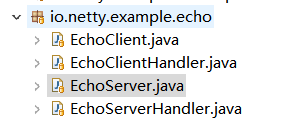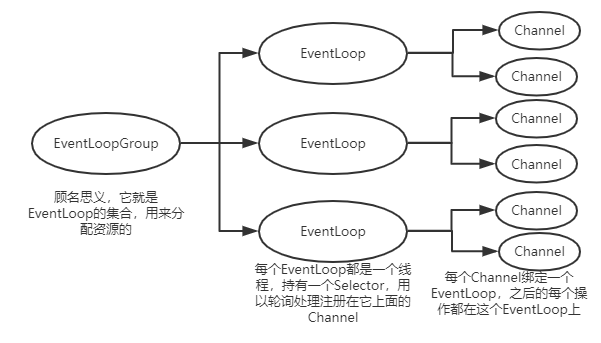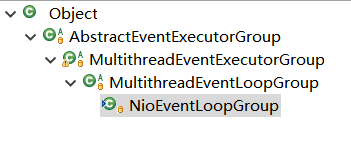2021SC@SDUSC
在这次博客中,着重介绍netty最为核心的组件EventLoop和EventLoopGroup。
目录
1.NioEventLoop与NioEventLoopGroup的关系
3.NioEventLoopGroup中的newChild函数
一. 引入示例
netty 提供了大量的 demo 供用户使用和测试,我们今天就从下图netty提供的EchoServer测试类出发,分析EventLoop和EventLoopGroup这两个核心组件。

类代码:
public final class EchoServer {
static final boolean SSL = System.getProperty("ssl") != null;
static final int PORT = Integer.parseInt(System.getProperty("port", "8007"));
/**
* @see io.netty.channel.nio.NioEventLoop
*/
public static void main(String[] args) throws Exception {
// Configure SSL.
final SslContext sslCtx;
if (SSL) {
SelfSignedCertificate ssc = new SelfSignedCertificate();
sslCtx = SslContextBuilder.forServer(ssc.certificate(), ssc.privateKey()).build();
} else {
sslCtx = null;
}
// Configure the server.
EventLoopGroup bossGroup = new NioEventLoopGroup(8);
EventLoopGroup workerGroup = new NioEventLoopGroup(16);
try {
ServerBootstrap b = new ServerBootstrap();
b.group(bossGroup, workerGroup)
.channel(NioServerSocketChannel.class)//new ReflectiveChannelFactory<C>(channelClass)
.option(ChannelOption.SO_BACKLOG, 100)
.handler(new LoggingHandler(LogLevel.INFO))// ServerSocketChannel 专属
.childHandler(new ChannelInitializer<SocketChannel>() {
@Override
public void initChannel(SocketChannel ch) throws Exception { // SocketChannel 专属
ChannelPipeline p = ch.pipeline();
if (sslCtx != null) {
p.addLast(sslCtx.newHandler(ch.alloc()));
}
//p.addLast(new LoggingHandler(LogLevel.INFO));
p.addLast(new EchoServerHandler());
}
});
// Start the server.
ChannelFuture f = b.bind(PORT).sync();
// Wait until the server socket is closed.
f.channel().closeFuture().sync();
} finally {
// Shut down all event loops to terminate all threads.
bossGroup.shutdownGracefully();
workerGroup.shutdownGracefully();
}
}
}
二. 分析
在main方法中,首先创建了关于SSL 的配置类,之后创建了两个EventLoopGroup 对象:
// Configure the server.
EventLoopGroup bossGroup = new NioEventLoopGroup(8);
EventLoopGroup workerGroup = new NioEventLoopGroup(16);这两个对象是整个 Netty 的核心对象,可以说,整个 Netty 的运作都依赖于他们。bossGroup 用于接受 Tcp 请求,他会将请求交给 workerGroup ,workerGroup 会获取到真正的连接,然后和连接进行通信,比如读写解码编码等操作。
1.NioEventLoop与NioEventLoopGroup的关系

EventLoopGroup构造:
首先EventLoopGroup声明如下:
// Configure the server.
EventLoopGroup bossGroup = new NioEventLoopGroup(8);
EventLoopGroup workerGroup = new NioEventLoopGroup(16);我们进入 NioEventLoopGroup类中查看:
NioEventLoopGroup的继承结构:

NioEventLoopGroup中包含的方法:

2.NioEventLoop的构造函数
/**
* Create a new instance using the specified number of threads, {@link ThreadFactory} and the
* {@link SelectorProvider} which is returned by {@link SelectorProvider#provider()}.
*/
public NioEventLoopGroup(int nThreads) {
this(nThreads, (Executor) null);
}
/**
* Create a new instance using the default number of threads, the given {@link ThreadFactory} and the
* {@link SelectorProvider} which is returned by {@link SelectorProvider#provider()}.
*/
public NioEventLoopGroup(ThreadFactory threadFactory) {
this(0, threadFactory, SelectorProvider.provider());
}参数最全的构造函数:
public NioEventLoopGroup(int nThreads, Executor executor, EventExecutorChooserFactory chooserFactory,
SelectorProvider selectorProvider,
SelectStrategyFactory selectStrategyFactory,
RejectedExecutionHandler rejectedExecutionHandler,
EventLoopTaskQueueFactory taskQueueFactory,
EventLoopTaskQueueFactory tailTaskQueueFactory) {
super(nThreads, executor, chooserFactory, selectorProvider, selectStrategyFactory,
rejectedExecutionHandler, taskQueueFactory, tailTaskQueueFactory);
}NioEventLoop构造函数非常多,每个参数都可以定制,我就不全贴出来了,最后回到这个参数最全的构造函数,下面我们挨个解释每个参数的作用:
- nThreads: 线程数,对应EventLoop的数量,为0时 默认数量为CPU核心数*2
- executor: 这个我们再熟悉不过,最终用来执行EventLoop的线程
- chooserFactor: 当我们提交一个任务到线程池,chooserFactor会根据策略选择一个线程来执行
- selectorProvider:用来实例化jdk中的selector,没一个EventLoop都有一个selector
- selectStrategyFactory:用来生成后续线程运行时对应的选择策略工厂
- rejectedExecutionHandler:跟jdk中线程池中的作用一样,用于处理线程池没有多余线程的情况,默认直接抛出异常
/**
* @param nThreads the number of threads that will be used by this instance.
* @param executor the Executor to use, or {@code null} if default one should be used.
* @param chooserFactory the {@link EventExecutorChooserFactory} to use.
* @param selectorProvider the {@link SelectorProvider} to use.
* @param selectStrategyFactory the {@link SelectStrategyFactory} to use.
* @param rejectedExecutionHandler the {@link RejectedExecutionHandler} to use.
* @param taskQueueFactory the {@link EventLoopTaskQueueFactory} to use for
* {@link SingleThreadEventLoop#execute(Runnable)},
* or {@code null} if default one should be used.
* @param tailTaskQueueFactory the {@link EventLoopTaskQueueFactory} to use for
* {@link SingleThreadEventLoop#executeAfterEventLoopIteration(Runnable)},
* or {@code null} if default one should be used.
*/上面的这些都是一些重载的构造方法,并加入了一些默认值,比如为null 的 executor,也有一个单例的选择策略工厂,还有一个默认的线程池拒绝策略等。下面才是 NioEventLoopGroup 真正的构造方法,在抽象父类MultithreadEventExecutorGroup中,代码如下 :
protected MultithreadEventExecutorGroup(int nThreads, Executor executor,
EventExecutorChooserFactory chooserFactory, Object... args) {
if (nThreads <= 0) {
throw new IllegalArgumentException(String.format("nThreads: %d (expected: > 0)", nThreads));
}
if (executor == null) {
executor = new ThreadPerTaskExecutor(newDefaultThreadFactory());
}
// 创建nThreads大小的EventLoop数组
children = new EventExecutor[nThreads];
for (int i = 0; i < nThreads; i ++) {
boolean success = false;
try {
// 创建具体的EventLoop,会调用子类NioEventLoopGruop中的方法
children[i] = newChild(executor, args);
success = true;
} catch (Exception e) {
// TODO: Think about if this is a good exception type
throw new IllegalStateException("failed to create a child event loop", e);
} finally {
if (!success) {
// 如果其中有一个创建失败,把之前创建好的都关闭掉
for (int j = 0; j < i; j ++) {
children[j].shutdownGracefully();
}
for (int j = 0; j < i; j ++) {
EventExecutor e = children[j];
try {
while (!e.isTerminated()) {
e.awaitTermination(Integer.MAX_VALUE, TimeUnit.SECONDS);
}
} catch (InterruptedException interrupted) {
// Let the caller handle the interruption.
Thread.currentThread().interrupt();
break;
}
}
}
}
}
// 把刚才创建好的EventLoop提供给EventExecutorChooser,用于后续选择
chooser = chooserFactory.newChooser(children);
// 添加一个EventLoop监听器,用来监听EventLoop终止状态
final FutureListener<Object> terminationListener = new FutureListener<Object>() {
@Override
public void operationComplete(Future<Object> future) throws Exception {
if (terminatedChildren.incrementAndGet() == children.length) {
terminationFuture.setSuccess(null);
}
}
};
for (EventExecutor e: children) {
// 循环加入
e.terminationFuture().addListener(terminationListener);
}
// 将EventLoop数组转成一个只读的set
Set<EventExecutor> childrenSet = new LinkedHashSet<EventExecutor>(children.length);
Collections.addAll(childrenSet, children);
readonlyChildren = Collections.unmodifiableSet(childrenSet);
}分析:
这部分代码很长,我们拆分来看:
1.如果 executor 是null,创建一个默认的 ThreadPerTaskExecutor,使用 Netty 默认的线程工厂。
if (executor == null) {
executor = new ThreadPerTaskExecutor(newDefaultThreadFactory());
}2.根据传入的线程数(CPU*2)创建一个线程池(单例线程池)数组。
children = new EventExecutor[nThreads];3.循环填充数组中的元素。如果异常,则关闭所有的单例线程池。
4.根据线程选择工厂创建一个 线程选择器,默认是对2取余(位运算),也可以顺序获取。
// 把刚才创建好的EventLoop提供给EventExecutorChooser,用于后续选择
chooser = chooserFactory.newChooser(children);5.为每一个单例线程池添加一个关闭监听器。
// 添加一个EventLoop监听器,用来监听EventLoop终止状态
final FutureListener<Object> terminationListener = new FutureListener<Object>() {
@Override
public void operationComplete(Future<Object> future) throws Exception {
if (terminatedChildren.incrementAndGet() == children.length) {
terminationFuture.setSuccess(null);
}
}
};6.将所有的单例线程池添加到一个 HashSet 中。
// 将EventLoop数组转成一个只读的set
Set<EventExecutor> childrenSet = new LinkedHashSet<EventExecutor>(children.length);
Collections.addAll(childrenSet, children);
readonlyChildren = Collections.unmodifiableSet(childrenSet);3.NioEventLoopGroup中的newChild方法
当一个新的Channel连接时,NioEventLoopGroup需要拿出一个NioEventLoop让Channel绑定,这个Channel之后的IO操作都在这个NioEventLoop上操作。这里就调用了newChild方法,代码如下:
protected EventLoop newChild(Executor executor, Object... args) throws Exception {
return new NioEventLoop(this, executor, (SelectorProvider) args[0],
((SelectStrategyFactory) args[1]).newSelectStrategy(), (RejectedExecutionHandler) args[2]);
}- 可以发现就是new NioEventLoop
- 可以看出先用来创建EventLoopGroup的参数其实都是用来创建EventLoop的
跟进NioEventLoop的构造函数
分析注释在代码中
NioEventLoop(NioEventLoopGroup parent, Executor executor, SelectorProvider selectorProvider,
SelectStrategy strategy, RejectedExecutionHandler rejectedExecutionHandler) {
//调用父类的构造方法,主要是将保存 线程组 NioEventLoopGroup
//创建一个21亿的任务队列
//executor负责创建线程执行器也保存起来。
super(parent, executor, false, DEFAULT_MAX_PENDING_TASKS, rejectedExecutionHandler);
/*非主线代码,忽略
if (selectorProvider == null) {
throw new NullPointerException("selectorProvider");
}
if (strategy == null) {
throw new NullPointerException("selectStrategy");
}*/
//provider=SelectorProvider.provider() jdk自带的用来创建ServerSocketChannel
provider = selectorProvider;
//openSelector方法负责将jdk自带的hashSet结构的selectedKeys 也封装成netty自己定义的SelectedSelectionKeySet里面是一个数组结构,这个优化是可以配置的。
final SelectorTuple selectorTuple = openSelector();
//替换了数据结构selectedKeys publicSelectedKeys的原生selector
selector = selectorTuple.selector;
//子类包装的selector 底层数据结构也是被替换了的
unwrappedSelector = selectorTuple.unwrappedSelector;
//selectStrategy=new DefaultSelectStrategyFactory()
selectStrategy = strategy;
}
newChild的大致流程:
- new NioEventLoop
- 保存前面创建的ThreadPerTaskExcutor
- 创建MpscQueue(任务队列)
- 创建selector
由于篇幅原因,关于NioEventLoop部分的分析,我们在下一篇博客中进行。




















 199
199











 被折叠的 条评论
为什么被折叠?
被折叠的 条评论
为什么被折叠?








